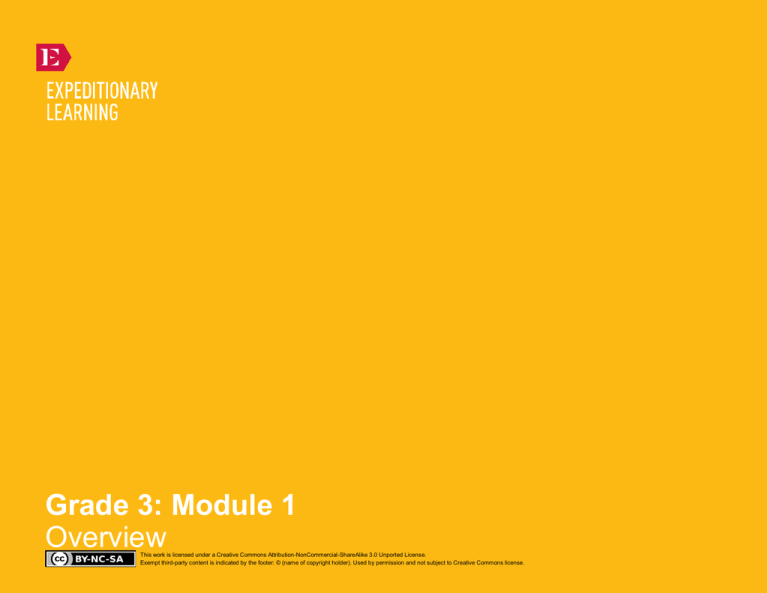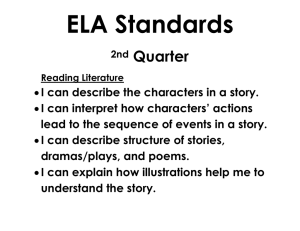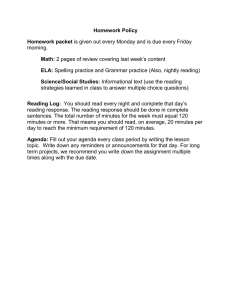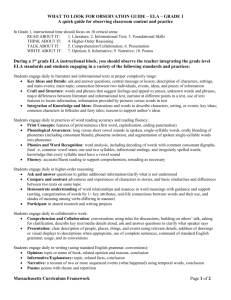
Grade 3: Module 1
Overview
This work is licensed under a Creative Commons Attribution-NonCommercial-ShareAlike 3.0 Unported License.
Exempt third-party content is indicated by the footer: © (name of copyright holder). Used by permission and not subject to Creative Commons license.
GRADE 3: MODULE 1: OVERVIEW
Becoming a Close Reader and Writing to Learn:
My Librarian is a Camel:
How Books are Brought to Children Around the World
This module uses literature and informational text such as My Librarian Is a Camel
to introduce students to the power of literacy and how people around the world
access books. This module is intentionally designed to encourage students to
embrace a love of literacy and reading. In Unit 1, students will begin to build their
close reading skills; students hear stories read aloud and read works in their
entirety and excerpts of more challenging writing closely. Students examine the
main message in literature about individuals and groups from world communities
(including the United States) who have gone to great lengths to access education.
Students will practice identifying the central message and taking notes in the
provided categories. Then in Unit 2, students will focus more on what it means to be
a proficient and independent reader. They will continue to read literature about
characters who are motivated to learn to read, overcome struggles to learn to read,
or are passionate about books and words. Students will assess their strengths and
needs as readers, set goals, and begin the yearlong journey of becoming proficient
and independent readers who have their own “reading superpowers.” (The phrase
“reading superpowers” is meant to help third-graders understand what is required
to demonstrate mastery of the Common Core reading standards.) This unit includes
a heavy emphasis on building reading fluency. In Unit 3 (the longest), students will
delve into geography, and how where one lives in the world impacts how one
accesses books. They will continue building knowledge and vocabulary related to
world geography as they study excerpts from My Librarian Is a Camel, which
describes how librarians overcome challenges of geography to get books to people.
They will apply their learning by writing a simple information report about how
people access books around the world, focusing on the role of specific librarians or
organizations they studied. This writing will be in the form of a bookmark, which
students can then give to their school or local library. The bookmark
performance task centers on NYSP12 ELA Standards RI.3.2, W.3.2,
W.3.4, W.3.5, and L.3.2.
Guiding Questions And Big Ideas
• What is the power of education and reading?
• How does where people live in the world affect how they access reading and books?
• People across the world and throughout time have sought the power of reading to provide opportunities to themselves and others.
• Powerful readers have and continue to develop a variety of skills.
• Readers can learn about different places and people through a variety of texts.
© 2012 Expeditionary Learning, New York, NY. All Rights Reserved.
NYS Common Core ELA Curriculum • G3:M1: Overview • June 2014 •
1
GRADE 3: MODULE 1: OVERVIEW
Becoming a Close Reader and Writing to Learn:
My Librarian is a Camel:
How Books are Brought to Children Around the World
Performance Task
Accessing Books around the World Bookmark
For this module, each student will create an “Accessing Books around the World” bookmark based on research about selected countries in the text My Librarian Is a
Camel and the geography content in Unit 3. Bookmarks will have two sides. On side 1, students will write an informative paragraph that explains about librarians
(individual or collective) from a specific country, and how they help readers access books in a unique way. On side 2, students will include a bulleted list about the
physical characteristics of the region as well as an illustration that represents the region’s geographical features. The creation of these bookmarks will be supported by
the writing process, including opportunities for critique, and culminating in the opportunity to publish and share the bookmarks with readers in their school or local
library. This task centers on NYSP12 ELA Standards RI.3.2, W.3.2, W.3.4, W.3.5, and L.3.1.
Content Connections
• This module is designed to address English Language Arts standards. However, the module intentionally incorporates Social Studies content that may align to
additional teaching during other parts of the day. These intentional connections are described below.
NYS Social Studies Core Curriculum
• World geography
• Maps/globes
• All people in world communities need to learn, and they gain knowledge in similar and different ways.
• Physical characteristics of a region strongly influence the culture and lifestyle of the people who live there.
© 2012 Expeditionary Learning, New York, NY. All Rights Reserved.
NYS Common Core ELA Curriculum • G3:M1: Overview • June 2014 •
2
GRADE 3: MODULE 1: OVERVIEW
English Language Arts Outcomes
CCS Standards: Reading—Literature
Long-Term Learning Targets
• RL.3.1. Ask and answer questions to demonstrate understanding of a text,
referring explicitly to the text as the basis for the answers.
• I can ask questions to deepen my understanding of a literary text.
• RL.3.2. Recount stories, including fables, folktales, and myths from diverse
cultures; determine the central message, lesson, or moral, and explain how it is
conveyed through key details in the text.
• I can retell a story using key details from the text.
• RL.3.3. Describe characters in a story (e.g., their traits, motivations, or feelings)
and explain how their actions contribute to the sequence of events.
• I can describe the characters in a story (their traits, motivations, feelings).
• RL.3.6. Distinguish their own point of view from that of the narrator or those of
the characters.
• I can distinguish between a narrator or character’s point of view and my own.
• RL.3.7. Explain how specific aspects of a text’s illustrations contribute to what is
conveyed by the words in a story (e.g., create mood, emphasize aspects of a
character or setting).
• I can explain how an illustration contributes to the story (e.g., mood, tone,
character, setting).
• RL.3.11. Recognize and make connections in narratives, poetry, and drama to
other texts, ideas, cultural perspectives, personal events, and situations.
• I can make connections between texts and ideas to comprehend what I read.
• I can answer questions using specific details from the text.
• I can identify the main message or lesson of a story using key details from the
text.
• I can describe how a character’s actions contribute to the events in the story.
• I can choose texts that interest me.
a. Self-select text based upon personal preferences.
CCS Standards: Reading—Informational Text
Long-Term Learning Targets
• RL.3.1. Ask and answer questions to demonstrate understanding of a text,
referring explicitly to the text as the basis for the answers.
• I can ask and answer questions about a text.
• RI.3.2. Determine the main idea of a text; recount the key details and explain
how they support the main idea.
• I can determine the main idea of an informational text.
© 2012 Expeditionary Learning, New York, NY. All Rights Reserved.
• I can retell key ideas from an informational text.
NYS Common Core ELA Curriculum • G3:M1: Overview • June 2014 •
3
GRADE 3: MODULE 1: OVERVIEW
English Language Arts Outcomes
CCS Standards: Reading—Informational Text
Long-Term Learning Targets
• RI.3.3. Describe the relationship between a series of historical events, scientific
ideas or concepts, or steps in technical procedures in a text, using language that
pertains to time, sequence, and cause/effect.
• I can make connections between the events, ideas, or concepts in a text.
• RI.3.7. Use information gained from illustrations (e.g., maps, photographs) and
the words in a text to demonstrate understanding of the text (e.g., where, when,
why, and how key events occur).
• I can use information from illustrations (maps, photographs) to understand
informational texts.
CCS Standards: Writing
Long-Term Learning Targets
• W.3.2. Write informative/explanatory texts to examine a topic and convey ideas
and information clearly.
• I can write an informative/explanatory text.
• I can use information from the words to understand informational texts.
• I can write an informative/explanatory text that has a clear topic.
a. Introduce a topic and group related information together; include
illustrations when useful to aiding comprehension.
• I can group supporting facts together about a topic in an
informative/explanatory text using both text and illustrations.
b. Develop the topic with facts, definitions, and details.
• I can develop the topic with facts, definitions, and details.
d. Provide a concluding statement or section.
• I can construct a closure on the topic of an informative/explanatory text.
• W.3.4. With guidance and support from adults, produce writing in which the
development and organization are appropriate to task and purpose. (Gradespecific expectations for writing types are defined in standards 1–3 above.)
• I can produce writing that is appropriate to task and purpose (with support).
• W.3.8. Recall information from experiences or gather information from print
and digital sources; take brief notes on sources and sort evidence into provided
categories.
• I can document what I learn about a topic by taking notes.
• W.3.10. Write routinely over extended time frames (time for research, reflection,
and revision) and shorter time frames (a single sitting or a day or two) for a
range of discipline-specific tasks, purposes, and audiences.
• I can write for a variety of reasons.
© 2012 Expeditionary Learning, New York, NY. All Rights Reserved.
• I can document what I learn about a topic by sorting evidence into categories.
NYS Common Core ELA Curriculum • G3:M1: Overview • June 2014 •
4
GRADE 3: MODULE 1: OVERVIEW
English Language Arts Outcomes
CCS Standards: Speaking & Listening
Long-Term Learning Targets
• SL.3.1. Engage effectively in a range of collaborative discussions (one-on-one, in
groups, and teacher-led) with diverse partners on Grade 3 topics and texts,
building on others’ ideas and expressing their own clearly.
• I can effectively participate in a conversation with my peers and adults.
b. Follow agreed-upon rules for discussions (e.g., gaining the floor in respectful
ways, listening to others with care, speaking one at a time about the topics
and texts under discussion).
• I can follow our class norms when I participate in a conversation.
• I can explain what I understand about the topic being discussed.
d. Explain their own ideas and understanding in light of the discussion.
• SL.3.5. Create engaging audio recordings of stories or poems that demonstrate
fluid reading at an understandable pace; add visual displays when appropriate
to emphasize or enhance certain facts or details.
• I can demonstrate fluency when reading stories or poems for an audio
recording.
• SL.3.6. Speak in complete sentences when appropriate to task and situation in
order to provide requested detail or clarification.
• I can speak in complete sentences with appropriate detail.
CCS Standards: Language
Long-Term Learning Targets
• L.3.2 Demonstrate command of the conventions of standard English
capitalization, punctuation, and spelling when writing.
• I can use conventions to send a clear message to my reader.
• I can capitalize appropriate words in titles.
– Capitalize appropriate words in titles.
• I can spell words that have suffixes added to base words correctly.
– Use conventional spelling for high-frequency and other studied words and for
adding suffixes to base words (e.g., sitting, smiled, cries, happiness).
• I can use spelling patterns to spell words correctly.
– Use spelling patterns and generalizations (e.g., word families, position-based
spellings, syllable patterns, ending rules, meaningful word parts) in writing
words.
• I can use resources to check and correct my spelling.
– Consult reference materials, including beginning dictionaries, as needed to
check and correct spellings.
© 2012 Expeditionary Learning, New York, NY. All Rights Reserved.
NYS Common Core ELA Curriculum • G3:M1: Overview • June 2014 •
5
GRADE 3: MODULE 1: OVERVIEW
English Language Arts Outcomes
CCS Standards: Language
Long-Term Learning Targets
• L.3.4. Determine or clarify the meaning of unknown and multiple-meaning
words and phrases based on Grade 3 reading and content, choosing flexibly
from a range of strategies.
• I can use what the sentence says to help me to determine what a word or phrase
means.
• L.3.6. Acquire and use accurate and grade-appropriate conversational, general
academic, and domain-specific words and phrases, including those that signal
spatial and temporal relationships (e.g., After dinner that night we went looking
for them).
• I can accurately use third-grade academic vocabulary to express my ideas.
© 2012 Expeditionary Learning, New York, NY. All Rights Reserved.
NYS Common Core ELA Curriculum • G3:M1: Overview • June 2014 •
6
GRADE 3: MODULE 1: OVERVIEW
Becoming a Close Reader and Writing to Learn:
My Librarian is a Camel:
How Books are Brought to Children Around the World
Central Texts
1. James Rumford, Rain School (New York: Houghton Mifflin Harcourt, 2010); ISBN: 978-0-547-24307-8.
2. Jeanette Winter, Nasreen’s Secret School (San Diego: Beach Lane Books, 2009); ISBN: 978-1-416-99437-4.
3. Heather Henson, That Book Woman (New York: Atheneum Books for Young Readers, 2008); ISBN: 978-1-4169-0812-8. (Teacher copy only)
4. Jeanette Winter, The Librarian of Basra: A True Story from Iraq (Houghton Mifflin Harcourt, 2005); ISBN: 978-0-15-205445-8.
5. Patricia Polacco, Thank You, Mr. Falker (New York: Philomel, 2001); ISBN: 978-0-39923732-4. (Teacher copy only)
6. Roni Schotter, The Boy Who Loved Words, illustrated by Giselle Potter (New York: Schwartz & Wade, 2006); ISBN: 978-0-375-83601-5. (Teacher copy only)
7. Oliver Jeffers, The Incredible Book-Eating Boy (New York: Philomel, 2007); ISBN: 978-0-399-24749-1. (Teacher copy only)
8. Monica Brown, Waiting for the Biblioburro, illustrated by John Parra (Emeryville, CA: Tricycle Press, 2011); ISBN: 978-1-58246-353-7. (Teacher copy only)
9. Margriet Ruurs, My Librarian Is a Camel: How Books Are Brought to Children around the World (Honesdale, PA: Boyds Mills Press, 2005); ISBN: 978-1-59078093-0. (Teacher copy only)
© 2012 Expeditionary Learning, New York, NY. All Rights Reserved.
NYS Common Core ELA Curriculum • G3:M1: Overview • June 2014 •
7
GRADE 3: MODULE 1: OVERVIEW
Week at a Glance
Week
Instructional Focus
Long-Term Targets
Assessments
• Introduce Superheroes of Reading around
the world; introduce close reading
• I can identify the main message or lesson of
a story using key details from the text. (RL.2)
• Mid-Unit 1 Assessment: Collaborative
Discussion Skills (SL.3.1b and c)
• Read and discuss stories from around the
world about people seeking the power of
education, learning, and reading
• I can follow our class norms when I
participate in a conversation. (SL.3.1b)
Unit 1: Seeking the Power of Reading
Weeks 1-2
• Launch independent reading
• Introduce paragraph writing
• I can ask questions so I’m clear about what is
being discussed. (SL.3.1c)
• I can ask questions that are on the topic
being discussed. (SL.3.1c)
• I can connect my questions to what others
say. (SL.3.1c)
• Practice close reading and note-taking
• I can identify the main message or lesson of
a story using key details from the text.
(RL.3.2)
• End of Unit 1 Assessment: Close Reading
and Powerful Note-Taking (RL.3.2, RL.3.3,
W.3.8, and L.3.4)
• I can document what I learn about a topic by
sorting evidence into categories. (W.3.8)
• I can document what I learn about a topic by
taking notes. (W.3.8)
• I can use a variety of strategies to determine
the meaning of words and phrases. (L.3.4)
© 2012 Expeditionary Learning, New York, NY. All Rights Reserved.
NYS Common Core ELA Curriculum • G3:M1: Overview • June 2014 •
8
GRADE 3: MODULE 1: OVERVIEW
Week at a Glance
Week
Instructional Focus
Long-Term Targets
Assessments
• I can write an informative/explanatory text.
(W.3.2)
• Mid-Unit 2: Assessment: A Letter about My
Reading Goals (W.3.2 and L.3.6)
Unit 2: Building the Power of Reading
Weeks 3-4
• Learn about and build the personal powers
of reading through stories and classroom
structures (e.g., vocabulary, independent
reading stamina)
• I can accurately use third- grade academic
vocabulary to express my ideas. (L.3.6)
• Set individual reading goals and write an
informational letter about those goals
• Develop reading fluency and create an oral
recording of fluent reading for an audience
© 2012 Expeditionary Learning, New York, NY. All Rights Reserved.
• I can demonstrate fluency when reading
stories or poems for an audio recording.
(SL.3.5)
• End of Unit 2 Assessment: Listen Up!:
Recording Our Reading (SL.3.5)
NYS Common Core ELA Curriculum • G3:M1: Overview • June 2014 •
9
GRADE 3: MODULE 1: OVERVIEW
Week at a Glance
Week
Instructional Focus
Long-Term Targets
Assessments
• I can answer questions using specific details
from the text. (RI.3.1)
• Mid-Unit 3 Assessment: Librarians around
the World: Answering Text-Dependent
Questions (RI.3.1, RI 3.2, W.3.8, and SL.3.1)
Unit 3: Librarians around the World
Weeks 5-8
(17 sessions)
• Introduction to geography: Building
background knowledge about physical
environments and reading maps
• Revisit Close Reading protocol
• I can determine the main idea of an
informational text. (RI.3.2)
• Determine the main idea of informational
texts about accessing texts around the world
• I can document what I learn by sorting
evidence into categories. (W.3.8)
• I can effectively participate in a conversation
with my peers and adults. (SL.3.1)
• Plan, draft, revise, edit, and publish a
Librarians around the World informative
paragraph
• Create an Accessing Books around the World
bookmark that explains how librarians or
organizations help readers access books in a
unique way
© 2012 Expeditionary Learning, New York, NY. All Rights Reserved.
• I can write an informative/explanatory text.
(W.3.2)
• I can group supporting facts together about a
topic in an informative text using both text
and illustrations. (W.3.2)
• End of Unit 3 Assessment: Accessing Books
around the World: On-Demand Informative
Paragraph about a New Country (W.3.2)
NYS Common Core ELA Curriculum • G3:M1: Overview • June 2014 •
10





